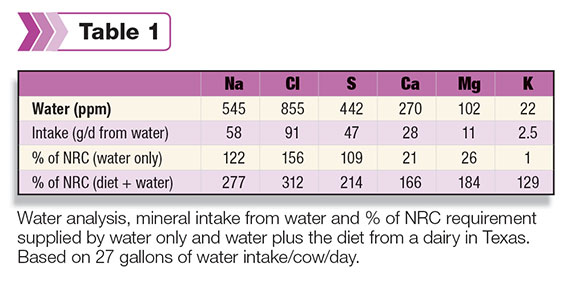Take a look at the water in the troughs for your cows. There doesn’t seem to be much to it except maybe a little slimy growth or some feed particles. It’s just this clear, cool stuff we (usually) pump out of the ground and give to the cows without a second thought. But look again. Or better yet, get it analyzed and evaluate what that water is delivering to your cows.
The 2001 Dairy NRC called water “the most essential nutrient” and yet as farm owners, managers and advisers, we almost never consider it as a nutrient, nor do we account for the actual mineral nutrients that it provides.
Click here to learn about a water analysis website the author of this article developed, which his employer currently sponsors for free use.
The time has come that every dairy should make that accounting and quantify what minerals are being provided in water for cows. Here’s why:
- If we don’t account for the minerals provided by water, we frequently oversupplement the diet beyond what the cow requires. This is not only expensive but can lead to salinization of soil where we spread manure and a further increase in mineral content of water.
- Most water supplies will provide only a few grams of mineral in a cow’s daily consumption of water. But many water sources will provide tens to hundreds of grams of mineral, which can antagonize the availability of vital trace minerals or even reach toxic levels.
- The combination of minerals delivered to the cow in water and feed can alter her acid-base status, with implications for rumen function or fresh-cow health. We account for the feed minerals in the DCAD calculation. We should do the same for water.
In a recent Journal of Dairy Science article, Dr. Alejandro Castillo and co-workers described the contribution water made to the total mineral intake of lactating cows and contrasted that with the mineral excretion in milk and manure.
For all minerals except sodium and chloride, the water contributed less than 4 percent of total intake. However, including intake from water increased the sodium intake by 9.3 percent and chloride intake by 6.5 percent.
Without compensating for this increased sodium and chloride intake, by reducing dietary salt, the potential exists to continue the build-up of salt in the soils and groundwater. The salinization of soils is a common reason for declines in crop yields.
For an upcoming Cornell Nutrition Conference paper, we summarized the results of 6,460 water analyses conducted by DairyOne forage lab in Ithaca, New York and Dairyland Laboratories in Arcadia, Wisconsin.
From that, we calculated the intake of minerals from an “average” sample for cows drinking 26 gallons of water per day. For most of the minerals, the intake from water was very low.
But for sodium, chloride and sulfur, water provided enough mineral to meet 28 percent, 34 percent and 39 percent, respectively, of the cows’ daily requirements for those minerals.
Sulfur from water is probably the mineral with the greatest concern because more than 8 percent of the samples had enough sulfur, when provided in combination with dietary sulfur, to potentially antagonize the availability of copper and selenium.
In this large dataset on water quality, we also find that the averages are misleading. The average water sample would provide at most 27 grams of chloride, the mineral with the highest average value. However, 23 percent of the individual samples had at least one mineral over 500 ppm.
At that level, the water is providing at least 60 grams of one or more minerals. When added to the dietary minerals, this could be enough to negatively affect cows. Consequently, each dairy should analyze its water supply to determine if the contribution of minerals is enough to warrant any action.

A dairy producer from Texas recently shared their water analysis and diet information with me because of some long-standing concerns with water quality ( Table 1 ).
When evaluated, this water supply is providing enough sodium, chloride and sulfur to fully meet the cows’ NRC requirements for these minerals.
Reducing dietary salt will be an effective means to lowering sodium and chloride intake to more closely match the cows’ requirements.
The dietary sulfur is well balanced to meet requirements, but the water takes sulfur intake up to a level where it will antagonize the availability of copper and selenium.
Opportunities also exist to reduce dietary calcium and magnesium to bring them in line with the cows’ actual needs.
In the past, many have questioned the bioavailability of minerals provided by water.
Electrochemically, they are exactly the same as the minerals provided in the diet, the main difference being that dietary minerals were dug out of the earth, while water-borne minerals were extracted when dissolved in water and pumped out.
When they get into the aqueous environment of the rumen and digestive tract of the cow, they are all going to behave in the same ways in terms of solubility, ionic interactions and absorption.
The minerals from water will also contribute to the DCAD status of cows just as the dietary minerals do. (See Progressive Dairyman article online )
The water supply described above has a negative strong ion difference (the water equivalent of DCAD), which is probably great for pre-fresh cows but will likely alter rumen function of lactating cows and drag the DCAD out of an optimal range for dry matter intake and milk production.
One symptom this dairyman describes is a very low butterfat test. Water is likely just one of several contributing factors.
Water is an essential nutrient for dairy cows. Often, its contribution to actual nutrient intake is minimal.
However, in a large number of dairy water supplies, one or more minerals will be present in sufficient quantity to contribute significantly, and sometimes detrimentally, to the mineral nutrition of cows. To assess whether it is an issue for your cows, you should:
- Establish a baseline of water quality across seasons by analyzing four water samples over the course of a year. If there is little variation across the year, just assess every other year to make sure nothing has changed.
- Calculate the intake of minerals from your water supply to evaluate the need to alter dietary mineral supplementation or, in extreme cases, treat or change the water supply.
- Assess the potential for water to be affecting the acid-base status of your cows and whether you need to change the DCAD program for either pre-fresh or lactating cows.
- Lastly, go out and take a look at your water troughs. Even if the minerals aren’t a concern, ask yourself if you’d like to drink from that trough. If not, get on a regular program to clean them up so that your cows have enticing access to the most essential nutrient. PD
Charlie Elrod has a Ph.D. in reproductive physiology from Cornell University and has spent the last 30-plus years working in the dairy industry.
References omitted due to space but are available upon request. Click here to email an editor.

Charlie Elrod
Dairy Division - Vice President
Vi-COR Inc.






